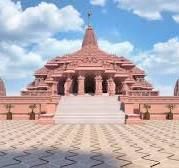Essay on Ayodhya Ram Mandir
Introduction:
The Ayodhya Ram Mandir, located in the heart of Ayodhya, Uttar Pradesh, is a symbol of historical resolution to a long-standing dispute. This essay explores the history, legal journey, cultural significance, and architectural marvel of the Ayodhya Ram Mandir, emphasizing its role as a unifying force in India’s diverse cultural landscape.

Historical Background:
Ayodhya, believed to be Lord Rama’s birthplace, has been a center of religious and cultural importance. The Ram Janmabhoomi-Babri Masjid dispute over the sacred land led to tensions for many years. The demolition of the Babri Masjid in 1992 intensified the conflict. The legal battle over the site continued for decades until the Supreme Court’s landmark decision in 2019, granting the land for the construction of the Ram Mandir.
Legal Journey:
The Supreme Court’s decision marked the end of a prolonged legal battle, providing closure to a divisive chapter in Indian history. The court’s judgment carefully considered historical evidence and principles of justice, striking a balance to bring an end to the dispute. The verdict also allotted an alternate plot for the construction of a mosque, emphasizing inclusivity and secular values.
Cultural and Symbolic Significance:
The Ayodhya Ram Mandir holds cultural and symbolic significance beyond its religious importance. Its construction represents an opportunity for healing historical wounds and fostering communal harmony. The commitment to building both the temple and the mosque showcases India’s dedication to unity in diversity. The government’s inclusive approach reflects a desire for reconciliation and a shared cultural heritage.
Architectural Marvel and Design:

